-
Posts
2,748 -
Joined
-
Last visited
Posts posted by John Whiting
-
-
I’ve been asked in advance about substitutes. For two weeks working in Banff, Scotland, I shared a house with two French musicians. Having much less to do than they (always my guilty secret on these musical/gastronomic tours), I offered to cook for the three of us. Our kitchen was remarkably well-equipped, so I set about adapting some of my favorite dishes to locally available ingredients. In the case of Cape Cod chowder, this was made easy by a wharf-side fish shop only a short stroll away, and chicken with forty cloves of garlic was satisfyingly authentic with a properly corn-fed free range bird from the local Tesco’s.
Cassoulet presented more of a challenge. Chicken had to substitute for goose or duck, green fatty bacon for pork belly. Even dried haricot beans were unobtainable, only broad butter beans; but these are in fact closer to what was traditional until well into the 19th century. There was plenty of good lean pork, lamb and acceptable sausage. As for the lack of a cassole to bake it in, a large bread bowl from a local shop was almost exactly the same size and shape, thus allowing the requisite expanse of crust. (No goose fat but, as any Jewish mama will tell you, there’s nothing wrong with good chicken schmaltz.)
The result, roundly acclaimed by my Languedoc-conditioned diners, reinforced my suspicion that method can be more crucial than precise ingredients for achieving an acceptable approximation of the authentic. That of course was Julia Child's premise when she set out to write Mastering the Art of French Cooking. She wrote in the intro that it could have been called French cooking from an American Supermarket.
Even the barrier of relative poverty can be surmounted. MFK Fisher, in her autobiographical Long Ago in France, writes admiringly of her skinflint Dijon landlady, Madame Ollangnier. She was notorious in the local markets for buying their cheapest merchandise, however unpromising:
Storekeepers automatically lowered their prices when they saw her coming…Up would come the trapdoor to the cellar, and down Madame would climb…he would pick up a handful of bruised oranges, a coconut with a crack in it, perhaps even some sprouting potatoes…And yet…from that little hole, which would have made an American shudder in disgust, she turned out daily two of the finest meals I have ever eaten. -
Strange you should mention this. I've a used hardback copy I bought several years ago on a whim. I started reading it and was put off by the heavy dose of whimsy, but kept going and was soon impressed by the author's ability to sum up the tone of a restaurant in a few well chosen words. I can't vouch for his total accuracy, but I came out at the other end with affectionate memories of restaurants I will never visit. And vicarious Michelin dining is a lot cheaper than the real thing.Speaking of caneton, you may like the book Feeding Frenzy: Across Europe in Search of a Perfect Meal by Stuart Stevens.EDIT: Marco, what are you doing up at this hour after all that heavy excercise?!

-
I shop, therefore I eat
The third area of London where we shop regularly is the rising middle class haven that Ronnie Barker called “Muzwell on the 'ill”. According to legend, it got its name from a mossy well, which has now been replaced by Moss Bros. (That’s an extended in-joke for eGullet Brits.)
The commercial area of Muswell Hill is rapidly being invaded by trendy delis, but some good old-fashioned shops survive. Foremost among them is Martyn’s, a “dry goods” grocery store that started in 1897. The exterior looks as if it were remodelled sometime in the art deco area, but certainly not later. Their usually splendid window was today in the midst of redecoration.
Modern coffee shops often employ artificial scent dispensers to draw in customers, but Martyn’s has an ancient coffee roaster in the window, still sending its heavenly aroma out into the street. That’s William, the present generation of the Martyn family, loading it up:
Once inside, every architectural detail is from a long-gone era. This is where Mary comes for the Marriage organic stone-ground flour from which she makes our bread, and also for most of the dried fruits and nuts that go into her cakes and Christmas puddings.
The raw coffee beans are on the floor, conveniently close to the roaster…
…and overhead are the storage tins for the tea. Yes, it’s all real – I took these photos this afternoon.
Some of Muswell Hill's ancient history is modern. Just along the street from Martyn’s is a brand new Gaudi shop front. It’s such a departure from the MacDonalds/Boots/W.H. Smith norm that the local council has ordered that it be destroyed and replaced by a plastic obscenity. Thousands have signed a petition in favor of its preservation, and the owners are fighting for their lives.
Tonight’s and tomorrow’s dinner demanded a bit of the dairy hard stuff, so Mary and I went to the unambiguously named Cheeses. It occupies one of a row of Edwardian shop fronts that have miraculously escaped the plague of modernization.
A quarter of parmesan and six ounces of two-year-old gouda. It cost about a fiver and half an hour's conversation.
-
There’s more than one way to eat a duck.
Guided by Mirabel Osler’s A Spoon with Every Course, I once ate at Au Caneton, a wonderful restaurant in Orbec off the tourist track in Normandy, southwest of Rouen. My first visit was with Frank on the journey narrated at length in Through Darkest Gaul with Trencher and Tastevin. The second time I travelled with Mary, who was so taken with the restaurant and its cuisine that we stayed over at a local b&b chateau and ate there three times in two days.
Au Caneton is an elegant husband-and-wife restaurant that functions with very little extra help. The chef, Didier Tricot, is locally noted for his L’aiguillette de canard au citron. Is it original? “I never invent,” he says dismissively, “but I may adapt.”
So do I. My version of his duck breast recipe has become a tradition in our household. I’ve changed it to a degree that Mssr. Tricot would probably not approve of, but I lack his expertise. Part of the skill of cooking, I’ve learned, is acknowledging one’s limitations and still producing something agreeably edible. (I know a world-famous author of multitudinous cookbooks who admits that she can’t bake.) Here’s my own modest version of Mssr. Tricot’s splendid recipe. I cooked it again last night and Mary was gratifyingly enthusiastic, as always.
L’aiguillette de canard au citron(Lemon duck breasts)
salt and pepper
2 duck breasts
2 tsp. sugar
1 fl. oz. wine (or balsamic)vinegar
8 fl. oz. good veal or chicken stock
grated zest and juice of ½ lemon
2 tsp. Grand Marnier
Heat a small frying pan, without oil. At the same time begin to heat a small heavy roasting pan in the oven at 200°C/400°F/Gas Mark 6.
Salt the duck breasts lightly on the skin only.
Brown them skin side down in the hot frying pan. The object is to extract the fat and crisp the skins without drying out the flesh.
As the skins brown, add the sugar. When it starts to caramelize, add the vinegar.
Turn breasts in the sweet/sour mixture, coating them well. Transfer to the hot roasting pan skin side up, uncovered, and cook in the oven for 20 minutes, then check. How much longer you cook them will depend on how well done you want them.
While the duck is cooking, bring the stock to a boil in a separate pan and simmer until it starts to thicken. Add the Grand Marnier, the lemon juice and most of the zest. When the breasts are done, add as much of the pan’s fatty juices as your taste and diet will permit.
It’s customary in such recipes to slice the breast at an angle and fan out the slices. This makes a great photo but allows it to cool quicker than you can eat it. I prefer to leave it whole and have some warmth still left in the last bite.
-----------------------------------
Original recipe from Au Caneton, Orbec; as set down by Shaun Hill for Mirabel Osler’s A Spoon with Every Course and further adapted for my travel journal, Through Darkest Gaul with Trencher and Tastevin.
I make this rich dish even richer by accompanying it with semi-caramelized carrots julienne, sauteed very slowly in butter and a bit of stock. The only way I’ve found to cut them properly is with that massive piece of kitchen machinery, the Braun mandoline. It’s an instrument best not played with bare fingers; the slider is an essential accessory.
A folded oven glove is under the leading edge because the raw steel will leave permanent calling cards on your work surface. But there are non-skid rubber feet on the rear support. Curious.
Mary relieves the wicked richness with simply simmered leeks. Here’s our dinner, dished up for consumption rather than display.
We polished off the meal with a tiny remaining piece of mincemeat and apricot streusel. As the dish says reassuringly, it’s just fruit.
Mirabel’s book was reprinted in paper as The Elusive Truffle. Her preferred title was The Elusive Salamander, for reasons that become evident as you read it, but her first publisher insisted on A Spoon with Every Course, which applied only to the Normandy chaper. The paperback publisher reverted to the original title but insisted on truffle rather than salamander (too obscure), even though it bore no relation to the book’s content. Sigh.
The book is a masterpiece, so naturally both editions are out of print, but the paperback is curiously offered used through Amazon at 99p. Snap it up—it’s one of the greatest French food/travel books ever written.
-
That's what I get for citing a childhood legend without ever having checked it. The yolks of all chickens' eggs are of course yellow. You can tell from the one that's spread all over my face.Regarding egg shell colour, the colour of the feathers is immaterial. White Plymouth Rock's lay brown eggs and black Leghorns lay white eggs for instance. White egg layers
-
That's farely recent. Until the "health food" movement got underway, white eggs were regarded as more "hygienic" and were always favored by institutions as well as most households. Both my wife (in England) and I (in America) can remember brown eggs being regarded as vaguely "dirty".Except in eggs, Anglo-Saxons like brown eggs for some reason.The color is, of course, related to the color of the hen's feathers.
-
Worse than that! It was Blacking! Actually, I'm 1/32 Cherokee, but don't ask me which bit.
Actually, I'm 1/32 Cherokee, but don't ask me which bit.
This longing for a paler shade in all sorts of things including skin color seems to go way back into primitive history. "Black is beautiful" is, alas, a relatively recent slogan.I wonder if the preference in colour reflects the swinging of the pendulum between austerity and romanticism in anyway? -
Adam, thanks for the more precise info. It's ironic that down through history, the gentrification of dress, cuisine (including bread), religion and race have often involved the "purification" of color. White is also an archetypal attribute of death. Go figure.Portobello/Chestnut/Cremini is the remarketing of the older brown strain of the gilled mushroom Agaricus bisporus. This strain fell out of fashion after the development and hugely successful marketing of the white strain ("champignon de Paris") in the 1920's.What ever the market name I am glad they are back as they have more flavor then the white strain. It is odd to think that many of the classic dishes that use these as a ingredient or garnish, most likely didn't use the flavor lacking white strain at all.
-
Most efforts to establish authenticity end up playing with words. John Thorne has written very perceptively about the interlocking elements of culinary and cultural integrity. When you go to a different country, your cuisine changes as inexorably as your life style. You can't live in the middle of Manhatten and live the life of a hermit in an Amazon rain forest; neither could you cook the cassoulet of a woman like Elizabeth Luard's Madame Escrieux, who potted her own confit, grew her own beans and kept and slaughtered her own pig.Authenticity is something I've recently been giving a lot of thought to. I'm in love with Italian cooking and when I'm living in Italy, my food is Italian, it can be nothing else because of the ingredients. The bread I'll make is infused with the air of Umbria. But what happens when I'm in NY and I can only cook in the Italian style? Have I sacrificed all 'authenticity"? To be authentically Italian I should be using local NY products and not expensive imports. A conundrum methinks.Put it another way: Fusion cooking is the only kind there is.
-
I don't know about kosher Indian, but there's a kosher vegetarian society in Golders Green, also a kosher chinese restaurant in Temple Fortune--Marcus, I think--with a cartoon in the window of a rather rabinical-looking Chinaman pulling a rickshaw (at the least that's the way I remember it). It's been there for a long time.Are there some kosher Indian vegetarian places in London these days?I love South Indian vegetarian food. The very first one in London, Diwana Bhel Poori in Drummond Street, has been going strong since 1971. I know it from very soon after that, and their original dishes have changed not at all, only being supplemented by a few newer ones. Back then, these flavors were new to me, and they were like an epiphany. It still remains one of our favorite places to eat lunch. When I take strangers there, I order a "tasting menu" of all the starters. The benches are uncomfortable, which is fine by me--it makes the turnover fast enough so that we can always get a table at short notice.
The Time Out London Restaurant Guide used to list the Indian vegetarian restaurants together, but it has dropped the section and most of the individual restaurants as well. What reason can they have, other than mere fashion?
-
-
DOWN MARKET
The Borough Market is where I do my fun shopping; Mary does the real shopping at Chapel Market near the Angel, Islington. That’s where she gets most of our everyday fruits and veggies.
Yes, that will do!
And there’s the coriander, a fresh generous bunch for 60p. I trim the ends off the roots and put it in water…
…whereupon it springs gloriously back to life.
I use a lot in my lunches, taking it fresh from the jar for a couple of days and then cramming the rest into a freezer bag. After such rough treatment, it’s not pretty enough to sprinkle on salads, but for cooking, I can take slices off the frozen ball and stir them straight in, and the strong coriander flavor survives. It ain’t elegant, but I can’t go shopping every time I want a few fresh herbs. The meagre little force-grown supermarket bunches are about the same price and totally useless.
Mary makes our wholemeal bread, but she sometimes has slices of baguette for lunch, and I’ll need breadcrumb topping for the cassoulet and also for starters—pain grillé spread with tomatade.
Tomatade? What the hell is that?
Be patient, you’ll find out later.
Mary gets our French sticks from the Chapel Market’s Stiles Bakery.
There they are.They cost 80p, which would get you about one thin slice of Poilâne’s finest.
Unlike most baguettes these days, even in France, they’re not only crusty, but the next day they haven’t turned spontaneously into hardtack. There’s density, substance and flavor to the insides. We cut them into short lengths and freeze them in plastic bags; when thawed as needed, there’s still life in them. Freezing only ages bread by a day.
Chapel Market also has a pie and mash shop that has been brought gloriously back to life. It’s not my thing, but I’m glad it survived.
There’s a neat little stall that sells nuts and other dry odds-and-ends.
And for a generous lunch, there’s Indian Veg.
It’s a sort of Vegan Salvation Army where you can get fed really cheap if you’re prepared to be preached to at the same time. Fortunately, the preaching is silent, in the form of texts on the walls. It’s not a hippy mess, but is neatly laid out and kept spick-and-span. A help-yourself buffet costs an unbelieveable £2.95, and the dishes are genuinely tasty. OK, so it hasn’t the vegetable elegance of Alain Passard’s l'Arpege, but it comes at about 1% of the price. And no surcharge for seconds.
Here’s what I helped myself to for lunch today:
What gastronomic artistry! (I tried building a tower, but it fell over.) Note especially the carelessly-thrown-down whisp of onion bhajee, cleverly ballancing the whole bhajees on the other side of the plate. Truly a meal to be savored with the eye as well as the tongue.
-
-
As opposed to the older types with a weight sitting on the jet. Maintaining a constant pressure meant that there was always steam escaping, so that with not much liquid inside it could boil dry.Thank you! Spring-loaded...hmmm.The Demeyere has a small cylinder that gradually protrudes from the pressure gauge with three graduated rings around it. Top pressure is when the third ring is exposed. If it starts to hiss, you've too much heat, and you then back off until it stops. I've cooked safely and successfully with only a cup of water for a large load.
-
Our 8.5 litre Demeyere, Belgian-made, is in almost daily use. Our chicken bones go into it to make stock, which takes an hour for total extraction of flavor. Made under pressure, the stock isn't clear, but that doesn't bother us; the "impurities" that are removed by careful simmering, skimming and sieving are, for us, part of the flavor.Can you tell me why you value your pressure-cooker so much?Since the bones are steam-cooked under pressure, they don't have to be covered with water and the stock can be as strong as you like without reduction.
I also deal with tough game birds that I'd rather not wrestle with at the table by browning them at high heat in the oven in a loosely foil-wrapped dish, then transferring the covered dish to the pressure cooker on a low rack with a cup of water, and "steam roasting" it for as long as it takes to tenderize. I then put the covered dish back in a hot oven to dry out the skin a bit.
Since it's a spring-loaded pressure cooker that doesn't constantly lose steam, a small amount of water is enough. And it will have absorbed enough of the bird's flavor to make it worth adding to the stock pot.
So far as the pressure cooker's usefulness is concerned, that's just for starters.
-
If you've had Boston baked beans, you're only demivierge.I've also never had cassoulet, so be careful with all us virgins....
-
I won't even look, until after this blog closes down. I could be accused of plagiarism or contrariness.
-
Ah, Provincetown! Don't get me started! A glance at your website tells me that there are subjects we musn't pursue under eGullet auspices. Among the permitted ones, did you experience Sal's Place? Sal del Deo is a dear friend and one of the finest spontaneously natural cooks I've observed. Just watching him build a tomato sauce is a form of higher enlightenment.As somebody who once spent a lot of summer days vacationing (and eating--gotta keep this on-topic!) in Provincetown, I enjoyed jumping to your website just now and sampling some of your reflections on growing up there. Not to distract from the main theme of your blog, but any asides you might care to throw in here about life and food in Provincetown from the perspective a native would find a very interested audience over here. -
I haven't noticed any of their products disappearing in off seasons. As for duck fat, I haven't seen anyone offering it for sale. The costs are largely those of packaging and transportation, and the more prestigious goose fat is what most of the punters are prepared to pay for.I am admiring all that goose fat. Is this a seasonal offering or do they have it all the time? And I am assuming they have similar buckets of duck fat...yes? -
After pursuing culinary authenticity assiduously for years with a religious zeal, I’ve come to take a fairly relaxed view of it. This is partly the result of a paper I wrote for the Oxford Food Symposium this year; after I’d finished it, I changed the title to Authentic? or just expensive?
Where cassoulet is concerned, I’ve had some differences with Charles Shere of Chez Panisse—not arguments, really, for our friendship goes back forty years to when we were both working at KPFA in Berkeley—but rather an agreement to disagree. As a council of perfection, Charles’ and Lindsey’s recipe is the pinnacle. It takes up four pages in The Open Hand Celebration Cookbook and consumes generous hunks of the better part of a week to bring it to fruition. It starts with making the confit, then the stock, then a pork ragoût, then soaking and cooking the beans, and finally the assembly and baking of the cassoulet the day before it is to be served. (Like so many of the finer things in life, it is better warmed over.)
It’s a wonderful recipe with a wonderful end product, but I’ve simplified and deconstructed it in certain respects and added another element from the recipe I used to follow, that in Richard Olney's French Menu Cookbook. The lamb stew which he incorporates is exquisite in itself, and when it’s made with mutton, slow-simmered for several hours, it takes on heavenly dimensions. Details later.
First, the confit. Its origins lie in two historical factors: (1) the raw material from which it was made and (2) the method of its preservation. First, the meat of the geese or ducks that are force-fed to produce foie gras has a coarseness that does not take kindly to roasting or braising; it requires a rather more assertive treatment to tame it. Second, the production of foie gras at the height of the season produced such a massive by-product of left-over flesh that in pre-freezer days it had to be salted down or thrown away.
I love confit, but I also want to keep my salt intake within reason. These days, confit is not made so much for purposes of preservation as to meet a traditional demand. Ironically, many of the birds that are so preserved were not raised for foie gras, and so have a delicacy of flavor that fades under the violence of salting and preserving.
My own solution, for economy as well as aesthetics, is to collect and freeze duck legs that have reached their sell-by date at our local Waitrose and have been reduced. Then, at the beginning of cassoulet count-down, I thaw them and roast them slowly, covered, in the oven. I separate the fat and juices, remove the meat from the bones and cut it into bite-sized chunks. The bones then go towards making the large quantities of necessary stock. Containers start to accumulate in the freezer that will come out on Friday for the Saturday assembly.
Does the slow-roasted duck meat taste as good as confit? Is there a noticeable difference in the final cassoulet? A few years ago I asked Paula Wolfert what she thought and her off-the-cuff opinion at that moment was that the confit would need around six months maturation before it made much difference.
Please note that I’m not attempting to tie Paula to something she once said in idle conversation, or to establish a right and a wrong method of making a cassoulet, but am simply exploring alternatives that work to my own satisfaction. The same with the sausages. Some perfectly respectable recipes state that they should be parboiled; I prefer the taste of roasted sausage, so I cook them on a rack in a covered pan with a bit of water, in a medium oven for about an hour, taking them out when an insertion thermometer tells me they’re safely done—over 70ºC. They won’t be very brown, but they’ll be firm enough to cut into 1” lengths and store ‘til the fateful day.
The juices from the sausages then go into our big pressure cooker to steam-braise the pig’s feet. (This is one of the most essential pieces of equipment in our kitchen.)

Some recipes instruct that the feet should be split and cooked with the beans, but I have two objections. First, splitting produces bone splinters that take forever to remove; if they are cooked whole, any tiny bones you miss will be little round pellets, not life-threatening fragments. Second, I like the cartilage cooked well down so that it serves to thicken the cassoulet to an oleaginous unctuousness. (Say that slowly three times and your mouth will begin to feel as if you’ve already taken the first bite.) That takes up to two hours in the pressure cooker; by that time the beans would be reduced to a puree.
You can see already that I like to follow a cassoulet recipe that gives me maximum control over each ingredient and maximum flexibility as to timing--they ultimately cook so long together that there's no problem integrating the flavors. I make a ratatouille the same way, partially cooking each vegetable to its own schedule and then combining them for the final stage. It’s obvious that I’m not a chef with a restaurant’s demands for efficiency and last-minute completion, and that I have all the time in the world. For all I care, the Chopin minute waltz could last an hour.
-
Wise Mama! Vicarious is best for the waistline!Well, you know I'm a bit embarassed to admit I've never had a cassoulet, so I'll be very content to gaze deeply into the heart of the matter for an entire week.Thanks!
Zuke
-
My weekly trip to the Borough Market is a test of my won’t power (as opposed…). It is gradually evolving into a working market to rival the French and the Italians, and minus the endless junk stalls that one increasingly encounters all over Europe. Even though it has become a popular tourist destination, with endless varieties on offer of the ubiquitous burger-in-a-bun, the standards remain high, and vegetarians are offered food that’s as easy on the eye as on the tongue.
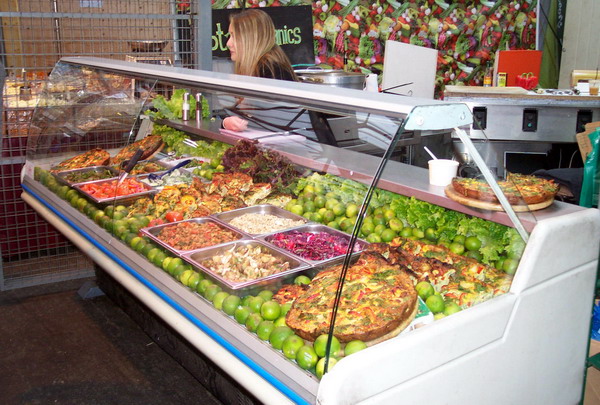
There are good sources of meat, cheese, condiments and various hard-to-find ingredients, nor will they necessarily make you bankrupt. The prominently located greengrocer Turnips may offer its produce at mind-boggling prices, but tucked off to one side is Booth’s, with a very good selection and a reasonable mark-up.
Every Friday morning through the summer I go to the Furness Fish Market for a fresh crab.
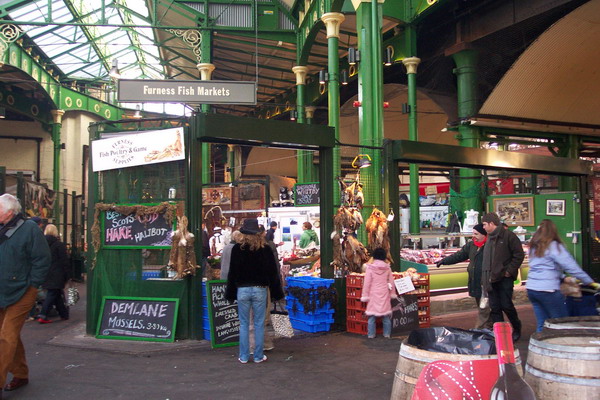
They’re at the far left end of the counter, where it’s easy to duck around the mass of customers waiting for fish. But I don’t usually have to fight the crowds. At lunchtime, both Friday and Saturday, the Borough Market is like opening day at a new Ikea branch, but between 11 and 11:30 on a Friday it’s easy to shop and everything is freshly laid out. (That’s when these photos were taken; otherwise they’d show merely the backs of people’s heads.)

There’s a good French cheese stall with lots of bargains. Its home base is Au Pot au Lait, Cremerie/Fromagerie, 17, Place de la Republique, 14100 Lisieux, Tel 31.61.04.03.
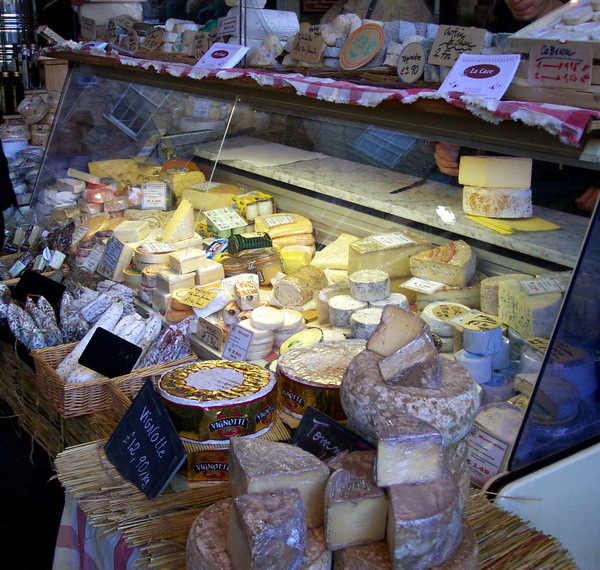
Dan Degustibus offers a wonderful selection of breads made with total integrity. There he is, waving at the camera.
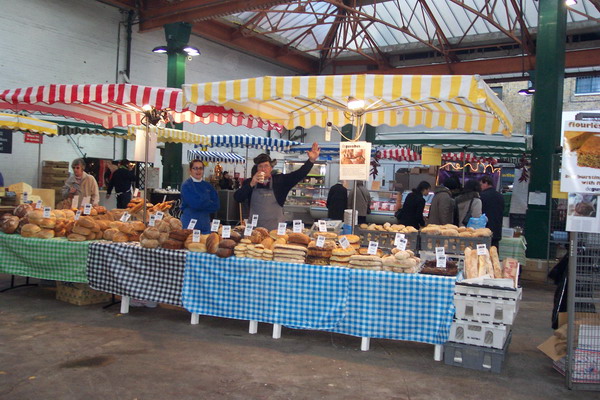
The essential reason for the day’s visit is the pork and lamb. For pork, I’m happy with the purse-friendly Sillfield Farm, with its jolly rustics straight from Central Casting.

Over on this side is the fresh meat, including an excellent Toulouse sausage. That’s what I’m here for, along with a couple of pig’s trotters and kilo of pork belly.
In the middle of the photo you’ll see a sign that reads Pork Haslet. That’s a Northern version of meat loaf, made of the sort of odds-and-ends that go into a haggis. They’re chopped fine and usually mixed these days with a bit of rusk to help hold it together. Sliced thin and eaten cold, it’s very satisfying with a pickled onion and a generous helping of home made apple chutney. If I were to go home each Friday without a few slices of haslet, I wouldn’t be let into the house.
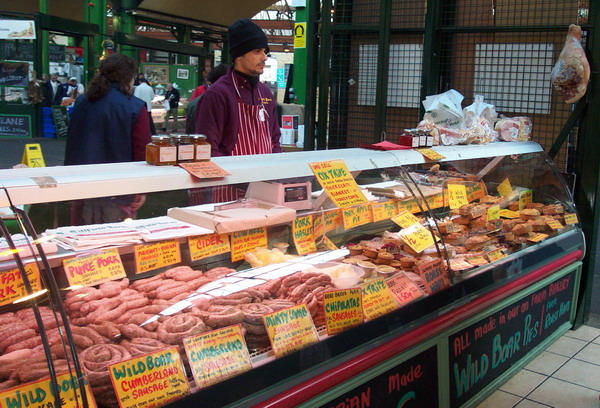
Next, it’s Farmer Sharp for a half-shoulder of mutton. To buy it these days, you usually have to go to a hallal butcher. On a large scale, mutton is available mainly to (as a butcher once told my wife) “the army, schools, hospitals and prisons”. Prince Charles has been doing effective PR on its behalf, and the flavorful stuff is once more becoming available from specialist suppliers.

There’s the cold case, where it sits waiting for me to give it a happy home.
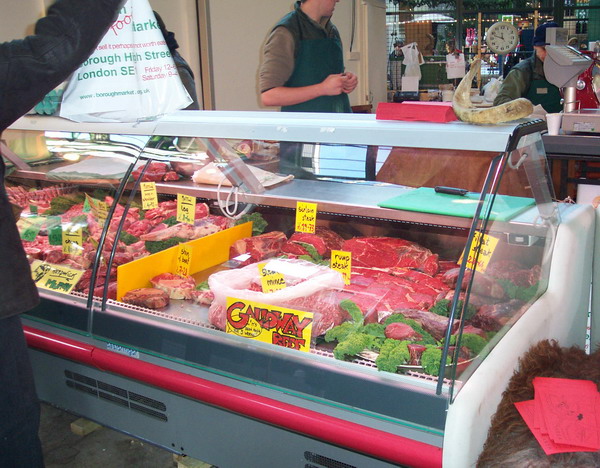
Finally, to Booth’s to bick up a celeriac.
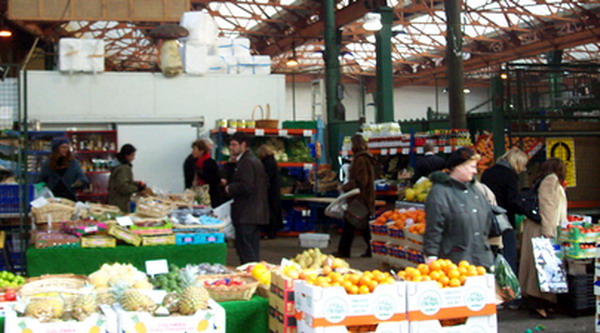
There it is, on the bottom shelf. As a first course before the cassoulet, I serve a remoulade of celeriac, essentially the recipe in Alice Waters’ Vegetable Cookbook.
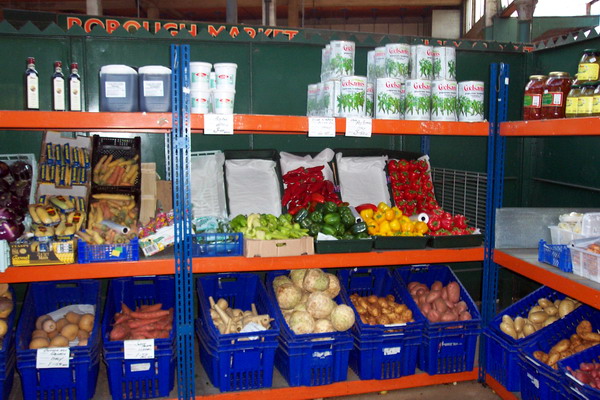
And there’s the check-out counter, behind an ever-changing array of wild and tame mushrooms, including the portobello, Ah, there’s a story. I’m told that the name was a PR invention, designed to sell large brown mushrooms for which there had been no market.
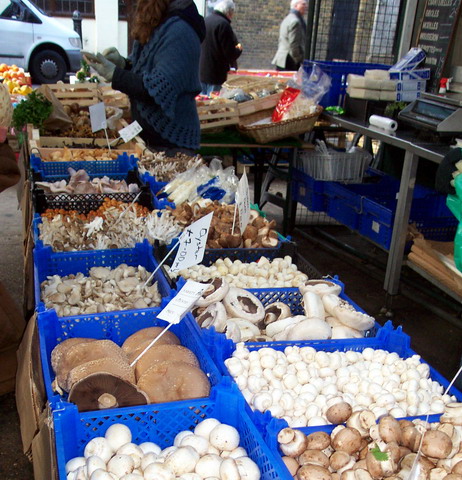
And so, back home on the Northern Line, having successfully resisted a plethora of tempting snacks. When I get home I’ll reward myself with something wicked, thus undoing all my noble self-denial.
-
Hard to say--maybe a couple of dozen. (Any more and I'd be buying my suits from a tentmaker!) And yes, they've all been different. Making cassoulets, like making love, should always contain an element of surprise.So... exactly (or approximately) how many cassoulets HAVE you eaten? And did you have a different one every time? -
My embarrassed apologies.
 I seem to have inadvertently posted an incomplete first installment. I've edited it and added the rest. For my next posting. I'm waiting for instructions as to how to insert photos from the ImageGullet file I've successfully set up.
I seem to have inadvertently posted an incomplete first installment. I've edited it and added the rest. For my next posting. I'm waiting for instructions as to how to insert photos from the ImageGullet file I've successfully set up.EDIT: I seem to have grasped the principle (see first post). Onward and upward!
FURTHER EDIT: Several generous offers of help. I think I've cracked it.




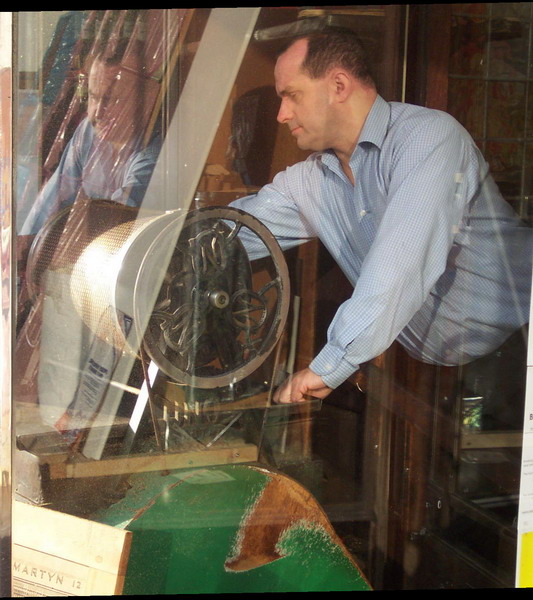
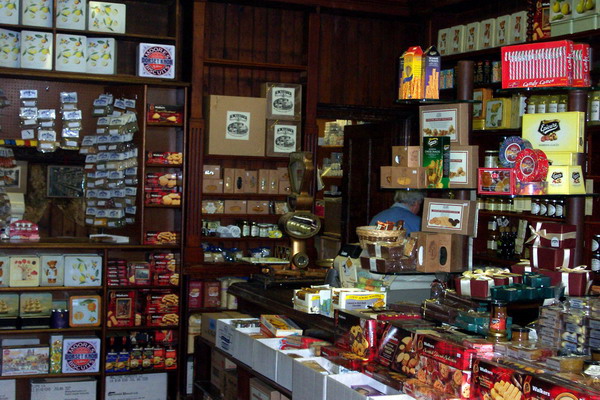
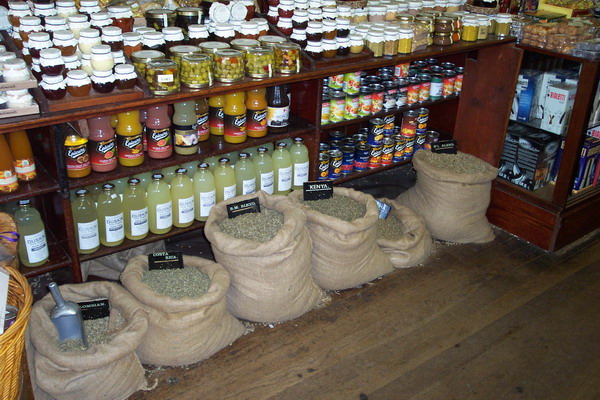
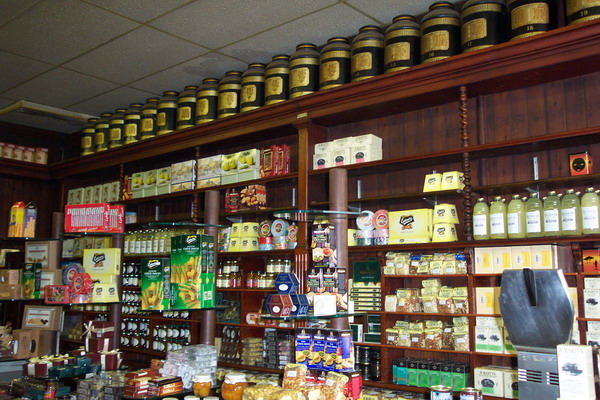


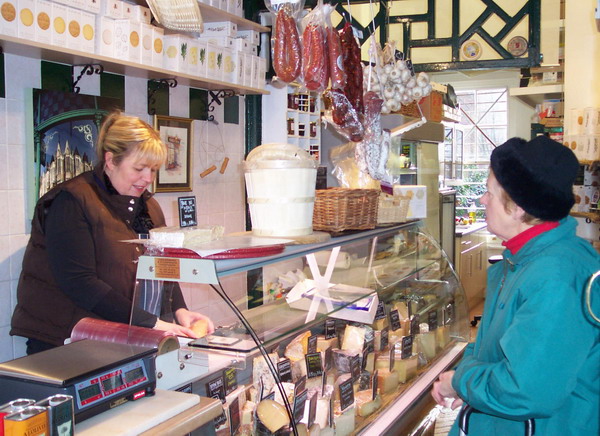
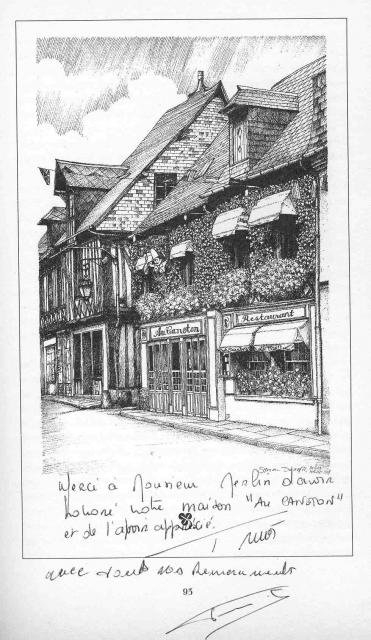

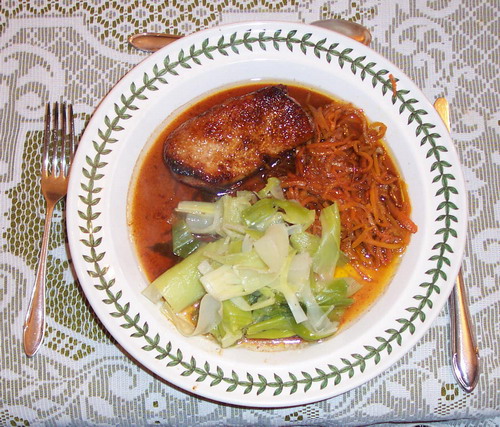
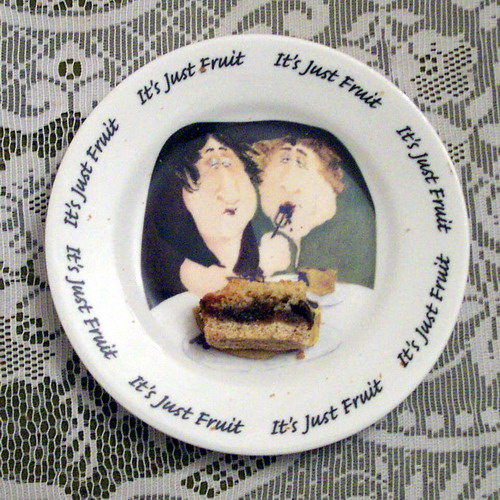
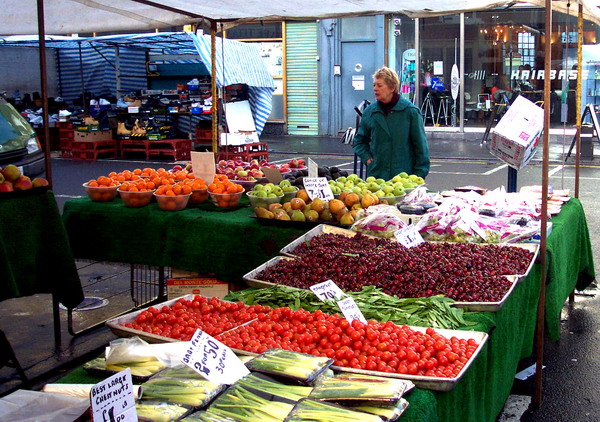
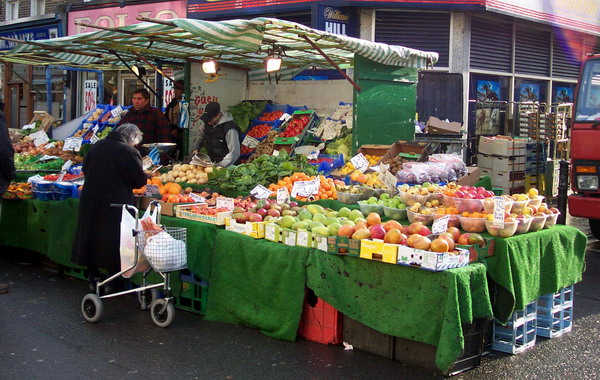
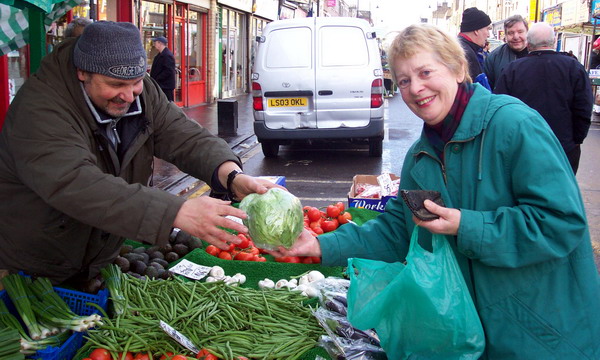
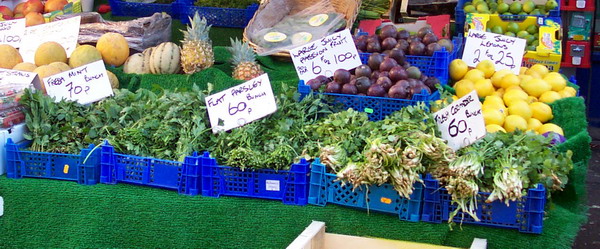
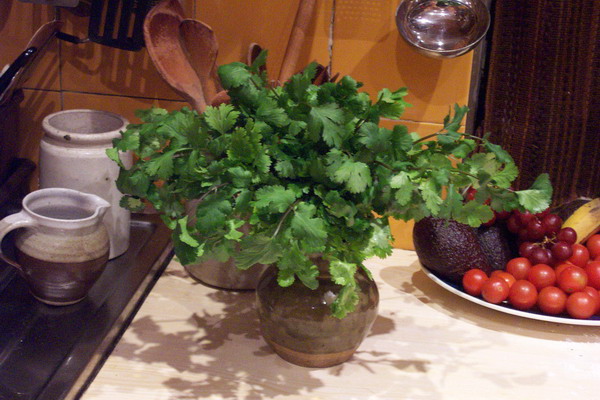
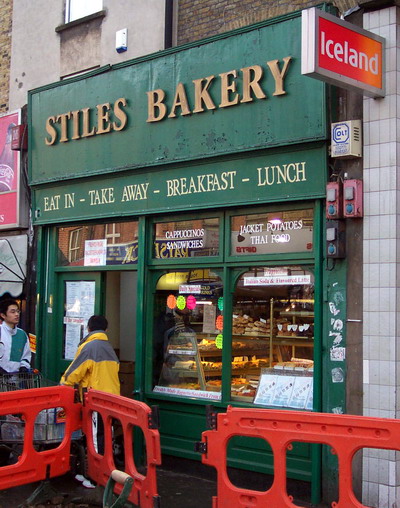
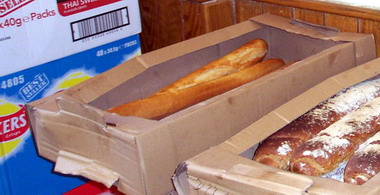


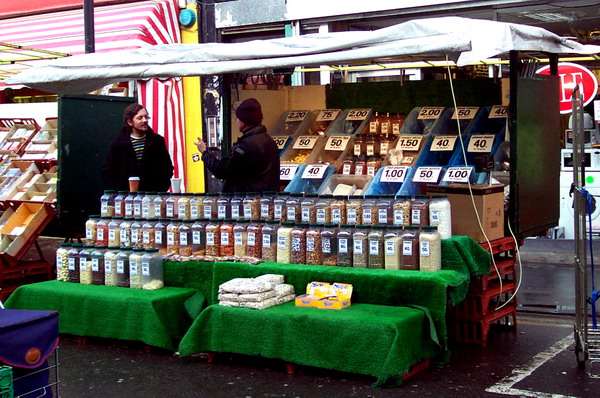
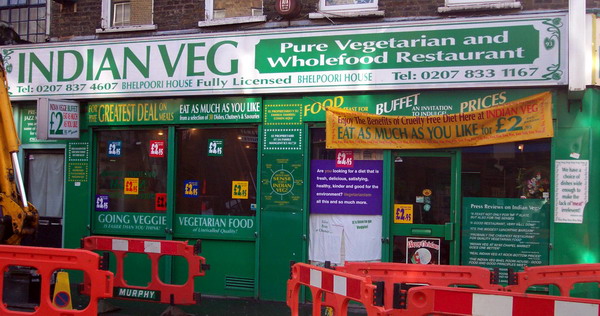

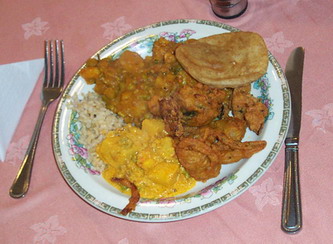
eG Foodblog: John Whiting
in Food Traditions & Culture
Posted